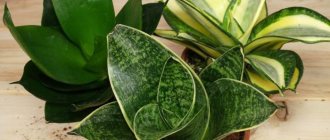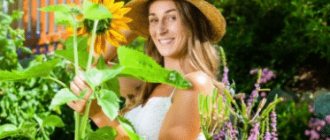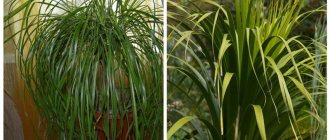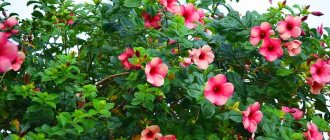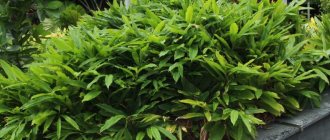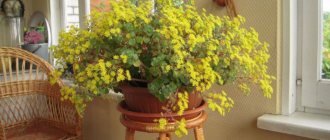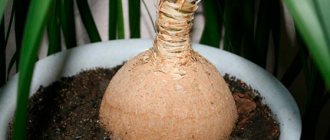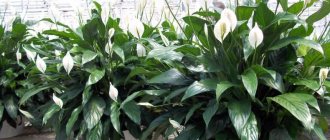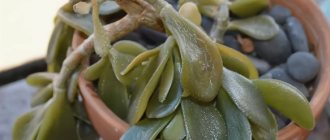Nolina is a houseplant with a very unusual appearance that immediately attracts attention. Another name for nolina is bocarnea (1), and gardeners often call it “bottle tree.” Indeed, the nolina stem has a characteristic expansion at the bottom, so it resembles a bottle. The “crown” of nolina consists of thin long leaves with a leathery surface, which grow in a bunch at the top of the trunk and give the plant a resemblance to a palm tree.
Nolina is native to Mexico and the southern United States. There it lives on poor drying soils, which is the reason for its unusual appearance. The thickening in the lower part of the trunk is a reservoir for storing moisture, and the specific shape of the leaves is needed so that the plant loses much less moisture by evaporation from their surface.
Types and varieties of nolina
Only one type of nolina flower is grown indoors - Nolina recurvata. It can reach a height of about 2 m, but usually remains more compact in indoor conditions.
On sale you can find plants with different types of formation: a single trunk with a “panicle” at the end or a branched one, each shoot of which has its own crown. These are not different varieties of nolina, but plants of the same species; the differences between them are created artificially during the growing process.
The youngest nolins look like bulbs sitting in the ground with a low crown; very often they are sold in pots of 3 pieces - over time, they most often grow together into one trunk, which gradually increases in height and takes on a characteristic “bottle” appearance.
What is a bottle tree?
A traveler who at least once in his life has seen a plant whose trunk resembles a capacious vessel will not confuse it with any other. The question of whether there is a small bottle tree worries many exotic lovers. Bocarnea or nolina is the name of an unusual, spectacular perennial belonging to the Dracaena family. The heterogeneous surface of the plant trunk resembles the skin of an elephant, for which it is also called the “elephant tree.” In its homeland, the size of bocarnea can reach 10 m and above; in indoor conditions, the largest specimens grow up to 2 m.
What does a bottle tree look like?
A distinctive property of nolina is the trunk, which has a thickening at the bottom. Under natural conditions, this bottle shape helps to accumulate moisture, which is necessary for survival in arid areas. The long, curved, dark green leaves of bocarnea grow in a cap, reminiscent of a horse's tail. In the wild they are used to weave baskets and hats - they are very durable. An indoor bottle tree will not grow to enormous sizes, as in its homeland, in the southern regions of America. Numerous plant species can decorate any interior.
Characteristics of the bottle tree
At home, the bottle tree does not bloom, but lovers of unusual plants enjoy growing it. The characteristics of nolina are amazing:
- The trunk, expanding downward, resembles the shape of an ancient vessel. This part has a scientific name - caudex, and is intended for the natural accumulation of moisture.
- The unusual structure of the bark looks like a cork, its task is to collect liquid. Some experts are sure that the peculiarity of the bottle tree is to absorb harmful impurities from the air.
- The long, narrow leaves grow from the center of the tree and cascade downwards and can be trimmed to give the crown different shapes.
Caring for nolina at home
Caring for a nolina flower is considered simple, but an inexperienced gardener may encounter a number of problems associated primarily with watering and wintering conditions for the plant (2).
Priming
As already mentioned, under natural conditions nolina lives on depleted soils, so fertile and dense soil is contraindicated for it. The soil for nolina should first of all be light, loose, water- and breathable. Ready-made compositions include mixtures for succulents and cacti, which can be enriched with charcoal or vermiculite.
If you prefer to prepare the soil yourself, then for nolina you will need a mixture of coarse sand, peat and garden soil, where sand should predominate.
Lighting
Nolina needs bright, diffused lighting and a fairly long daylight period. Direct sun, especially in summer, can harm it, but the lack of light does not have the best effect: in the shade, the nolina trunk stretches out, remains too thin and can become deformed, bending in the direction of the light.
Throughout the year, including during winter dormancy, the amount of light should be approximately the same, so caring for nolina in winter should include additional illumination with a phytolamp.
It is also useful to sometimes turn the pot so that the trunk does not bend and the crown does not become “one-sided,” since even on a light windowsill the illumination is never uniform.
Temperature
During the growing season, the plant thrives at room temperature, although in extreme heat (above 30 °C) the nolina flower may require additional care.
In the warm season, nolina can be taken out onto the balcony or terrace, taking care of protection from rain and drafts. In winter, the plant needs a rest period at a temperature of about 10 - 12 ° C, and the temperature should be lowered gradually, without sudden changes. Nolina can do without “hibernation” if the room temperature is more than 18 ° C, but the absence of a dormant period leads to the fact that the plant develops worse and lives less than it could.
Humidity
Nolina usually tolerates room humidity levels.
Plants that have not entered the dormant period may suffer from dry air in winter if they are located near heating devices or the humidity in the room is really abnormally low. In such cases, it is recommended to place the pot in a tray with damp expanded clay, pebbles or sphagnum.
Spraying and washing are not recommended; wiping the leaves with a damp cloth to remove dust is possible.
Watering
Watering is a very important point in caring for nolina. It tolerates dry soil more easily than waterlogging, so water the plant only after the earthen ball has completely dried out. Watering should be rare, but plentiful: frequent, scanty watering leads to elongation of the trunk and loss of decorativeness of the plant. Experts recommend watering the plant by immersing the pot in a basin of water so that the soil is well saturated with moisture. The water is then allowed to drain through the drainage holes and drained from the pan.
If nolina is provided with a cold winter, the plant is not watered at all or is done very rarely, only if the flower clearly shows a moisture deficiency: the trunk loses its elasticity and wrinkles.
If nolina overwinters at room temperature (18 °C and above), the watering regime remains the same as in summer, or a little less often, depending on the room temperature. As a rule, the warmer the conditions, the faster the earthen ball dries out and the more often it should be watered.
Water for irrigation should be moderately warm and low in salts, so it is advisable to settle tap water or pass it through a filter.
Fertilizers
Nolina can be fed with complex mineral fertilizers for indoor plants in half the dosage; it is advisable to use liquid formulations. Special fertilizers for cacti and succulents are also suitable.
Photo: pixabay.com
Feeding
To feed nolina, it is advisable to use liquid formulations and apply them immediately after watering once every 3-4 weeks.
It has been noticed that with a deficiency of nutrients, nolina forms a larger and thicker trunk, and with sufficient and excessive feeding, it forms abundant foliage.
Trimming
The plant does not need pruning; you just need to remove dried leaves as part of your normal nolina care.
Description of the plant
The genus Nolina belongs to the Agave family and includes about 30 species.
In its natural environment it grows in the northern regions of Mexico, on the southern borders of the United States. The plant grows to a height of 6 - 8 m. It prefers bright, sunny, warm and dry areas. Typically, at home, nolina is smaller in size and more decorative compared to wild representatives. Beaucarney received its name in the 19th century in honor of the French gardener P. Nolin.
When describing the species of this plant, special attention is paid to the unusual bottle-like trunk, widened downward, as well as thin, long linear leaves.
Nolina does not require special care; it is quite unpretentious. It does not bloom at home, but in its natural habitat you can see it blooming. The peduncle rises above the surface of the foliage. The flowers are small, yellow-white, collected in paniculate inflorescences, and have a pleasant, strong aroma.
The seeds are dark, flat, round in shape. They ripen after pollination of the flower and are collected in seed pods.
Of the total number of representatives of bocarnea species, only a few varieties can be purchased in flower shops in our country, for example, nolina bent, long-leaved, compressed, Nelson.
The unusual trunk and shape of the leaves allow the plant to retain and accumulate water in the lower swollen part of the trunk. This is a good quality for a tree growing in hot climates.
The plant has a superficial root system that grows in breadth.
Keep the potted plant away from pets as the foliage is very attractive to cats. Animals not only spoil the appearance of the tree, but can also become poisoned, since the plant is poisonous.
In our country, different types of nolina can be seen in arboretums, for example, standard nolina, the round trunk of which over time takes on a bottle-like shape. Depending on the species, several trunks may form during the growth process.
Branched nolina is highly valued as an ornamental plant.
There are superstitions and signs that are firmly attached to the plant. It is believed that a tree at home is capable of maintaining harmony and tranquility and has a positive effect on reducing aggression, rage and rage in the household.
Reproduction of nolina at home
Nolina can be propagated in two ways: by seeds and shoots.
Seeds. This option is only possible from purchased material - at home, nolina does not bloom and, accordingly, does not set seeds. Nolina seeds can be found at large suppliers of planting material; they are usually sold in packages of 3 - 5 pieces. But with this method of propagation, you need to take into account that not all seeds can sprout.
Before sowing, nolina seeds can be soaked in any growth stimulant for 24 hours. Then they are sown in a moistened mixture of peat and sand (1:1) and sprinkled with a thin layer of soil (the thickness of the layer is approximately equal to the size of the seed itself). The container with the crops is covered with film or glass, placed in a warm place and provided with round-the-clock lighting with a phytolamp, daily ventilation and regular moistening of the substrate as soon as it dries.
The average time for emergence of seedlings is from 3 to 5 weeks. After this, remove the film from the container and grow the plants in a warm, bright place for 2 - 4 weeks. Then they are planted in separate pots filled with substrate for adult plants, and watered as the earthen ball dries out. Young plants do not need fertilizing; they begin to be applied only after six months to a year. It is very important for young nolins to receive enough light, so it is advisable to supplement them with additional lighting.
By shoots. This is a rarer method due to difficulties in obtaining planting material. Nolina is capable of producing daughter shoots from dormant buds at the base of the trunk, but this happens infrequently.
If the plant has formed side shoots, they are allowed to grow a little, then cut off at the very trunk with a sharp, clean knife. The sections are treated with activated carbon. It is better to root the separated shoot in the ground. To do this, it is treated with Kornevin or another root formation stimulator, then planted in a moistened substrate of peat, sand and perlite or vermiculite (1:1:1). Cover the container with a transparent lid (for example, half a plastic bottle or glass jar) and keep it in a warm place in bright light. The mini-greenhouse is ventilated daily, the soil is moistened as the top layer dries.
A sign of rooting is the appearance of young leaves. When the shoot takes root, the mini-greenhouse is removed. The plant can be replanted into a substrate for adult nolina after a few months.
Possible problems and solutions
Caring for nolina at home is sometimes accompanied by problems that require an adequate solution:
- The leaves became dull and drooping. Most often, the cause of the problem lies in insufficient lighting. You need to put a pot of nolina on the window.
- The tips of the leaves have darkened . This happens when the air in the room is too dry. Although nolina can survive in drought conditions, you can try adding more humidity to the air (for example, using a humidifier or rubbing the leaves with water).
- The trunk wrinkled. The plant experiences a moisture deficiency and replenishes it from the caudex. Good watering should help combat this problem.
- The trunk is rotting. The most common cause is overwatering. It is necessary to withstand at least 10 days without irrigation. If the problem only progresses, the plant may not be able to be saved.
- A white coating appeared at the base of the trunk. This problem occurs when watering with too hard water. It is recommended to use filtered water for irrigation with the addition of a few drops of lemon juice.
drooping leaves
Nolina transplant at home
In the first 3 - 4 years, nolina grows very actively, so it needs a transplant every year. Plants older than this age are replanted less frequently, every 2 - 3 years, and very mature nolins (more than 10 years old) may no longer need replanting.
The nolina flower is usually replanted in late February or early March, before the plant comes out of dormancy. The pot for replanting should be the same depth as the previous one, but 2 - 3 cm wider - the root system of nolina is superficial and grows only in width.
If the plant overwintered in a warm place and did not stop growing during the winter, stop watering 7 - 10 days before replanting so that the substrate dries well. Then the nolina is carefully removed from the pot; the remains of the old earthen lump are not removed from the roots - you can only shake off the soil that crumbles on its own. When transferring to a new pot, you need to ensure that the plant, after filling with soil, is at the same depth as before.
Immediately after transplantation, nolina cannot be watered - this can only be done after a few days.
Transfer
Containers with several copies of seedlings usually go on sale. They require placement in separate containers. But there is no need to strive to transplant Nolina as quickly as possible after purchase. It should be replanted only after a week (at least) period of quarantine and adaptation to new conditions.
The roots require careful handling, so if possible, seedlings should be transferred by transshipment. After the plant is transplanted into a new container, a bag is put on it, leaving access to fresh air. It does not need to be removed until signs of leaf growth appear.
Domestic specimens require replanting approximately once every 3 years, but you should focus on the root system; by this time it should completely occupy the volume of the dish. An external sign of the need for housewarming is the cessation of leaf growth. The procedure remains the same.
Important! The thickened part must not be buried! The stem should remain in the ground at the same level.
Requirements for dishes
The roots of nolina, despite the arid conditions of wild growth, grow not in depth, but in breadth due to the shallow fertile layer of rocky soils. For this reason, she needs to select wide and fairly small bowls, paying special attention to their stability. Sometimes, for this purpose, several heavy stones are placed at the bottom of the pot, which additionally perform the drainage function that is extremely necessary for the plant.
When replanting older specimens, the diameter of the container is increased by 4 cm each time.
When transplanting, nolina is not watered! The plant is not able to absorb moisture in a state of adaptation; it will remain in the soil and lead to rotting of the roots.
Nolina diseases
Trunk rotting. This is the most common nolina disease. The reason is excess moisture in the substrate, that is, simply overflow. Signs of rot are softening of sections of the trunk, the appearance of weeping dark spots. Most often, the disease affects the lower part of the trunk above ground level.
Photo: pixabay.com
At the first signs of disease, watering is stopped until the earthen coma is completely dry, the diseased parts of the trunk are cut out with a clean tool, the wounds are dried and treated with 1% copper sulfate or a solution of potassium permanganate. After this, it is advisable to transplant the plant into fresh soil. If this is not possible, the soil in the pot is spilled with any suitable fungicide (for example, the same potassium permanganate in the form of a weak solution).
The main mistakes when growing nolina and parasite attacks
Nolina is characterized by the fact that it is practically not susceptible to attack by dangerous pests. Most growing problems arise as a result of improper care. Thus, external signs of deteriorating plant health can indicate to the grower his mistakes.
- Dryness of leaves and loss of their elasticity occurs due to excessively dry air and elevated temperatures. Moving to a cooler location will solve this problem.
- A wrinkled stem indicates a lack of water and quickly recovers after replenishing moisture.
- A reduction in the growth rate of the trunk signals that the tree needs nutrients. To correct the situation and resume development, it is enough to fertilize the soil.
- The falling of leaves and turning them brown indicates excess watering and the possibility of plant rotting. If the trunk is already covered with rot, reducing the flow of moisture is not enough - you must immediately cut out all the affected areas, sprinkle the cut areas with activated carbon and dry the trunk and root system well for 10 hours, then plant it in new soil.
If it happens that the roots of the nolina have completely rotted, you can thoroughly sanitize its trunk and re-root the plant by planting it in a substrate for succulents or cacti. Watering is resumed gradually. After some time, the bottle tree will give new roots.
Although the appearance of pests is extremely rare for nolina, if the plant is constantly in uncomfortable conditions of low light or excessive watering, it may well be attacked by scale insects, thrips or spider mites. They will take advantage of the tree's reduced immunity and attack it. It is the spider mite that is most common, since in the hot summer it infests on other indoor flowers and has the opportunity, if the opportunity arises, to move to a weakened crop.
To save the plant from harm, when the first signs of pest activity appear, you should wash the leaves with a soapy solution using cotton pads. In an advanced situation, when such a harmless method does not help, you will need to resort to the use of insecticides. The drug is used in accordance with the description in the annotation.
If you follow very simple rules for growing bottle trees, they will not cause any trouble, but will decorate their habitat and delight others with their exceptional exoticism.
Nolina pests
The nolina flower has no specific pests, but at very low air humidity it can be attacked by common pests of indoor plants: scale insects, mealybugs and spider mites.
Since the crown of nolina is small, and the trunk is not particularly interesting to parasites, the problem is most often solved by washing the plant with green or laundry soap. If there are a lot of pests on the nolina flower and the plant is severely affected, you will have to resort to agrochemicals and use Aktara (3) or any available insectoacaricide suitable for indoor plants.
How to properly care for the crop?
Nolina is an exotic plant that can adapt to any conditions, but in order for the tree to please the eye with its luxurious appearance, you should still adhere to some recommendations for caring for it.
Air temperature and humidity
Since the natural habitat of this plant is the desert, it loves warmth very much. In summer, it is optimal to maintain the temperature within +21-26 degrees, and in winter not lower than +7. If there is no precipitation in the summer, you can take the pot of nolina into the garden. Air humidity is not a particularly significant indicator for this type of flora; you just need to exclude as much as possible the possibility of water getting on the surface of the trunk, so as not to cause the process of rotting.
Lighting
But lighting is very important for the plant. When placing on a windowsill, it is advisable to choose the south or southwest side. When determining where to place a flower pot on the floor, you should find the brightest space. You can place nolina in direct sunlight - it is not afraid of them, but a lack of light will quickly lead to withering of the leaf part and loss of color. In addition, the plant will constantly reach towards the light source, and in order to prevent the trunk from bending, it is advised to turn the container in a circle by about 40-50 degrees once a week.
Watering mode
More than anything else, excess moisture is harmful to nolina. Excessive watering is practically the only way to destroy a bottle tree, because in nature it is used to receiving moisture extremely rarely. The best option would be to irrigate at two-week intervals in the spring and summer and stop moistening the soil in winter. Any water collected in the pan must be drained immediately. During the cold season, minimal watering is possible only if the plant trunk begins to lose elasticity.
Favorable soil for growing and fertilizing
Recurvate is ideally suited to a ready-made substrate intended for succulents. You can only add a little expanded clay to it to make the soil airier. As a top dressing, it is good to use activated or charcoal, or a mixture for the same succulents. The frequency of applying such fertilizers is 3 weeks.
If all of the above rules are followed, nolina will look like a well-groomed and healthy plant with a dense green part and a powerful, strong trunk, which will undoubtedly please any gardener.
What beneficial properties does the plant have?
Nolina is poisonous, so you should not make decoctions, tinctures, etc. from it. However, it also has beneficial properties. The plant improves the microclimate of the room in which it grows and helps saturate the air with oxygen and ozone. It also helps strengthen the immune system and nervous system. It is pleasant to be in the room where it grows; a good, friendly atmosphere is established. Therefore, a pot with such a plant can be placed both in a living space and, for example, in an office, etc.
For more plant care features, watch this video:
Useful articles:
Nolina Nelson - Nolina nelsoni
In nature, this variety reaches a height of 3.5 m and forms weakly branched, strong, thick trunks covered with light brown bark. At the top of each trunk there is a lush cap - a crown, consisting of narrow, linear leaf plates. The leaves are green, in most cases covered with a bluish waxy coating. There are tiny teeth along the edge of the leaves.
Nolina recurvata or bent - Beaucarnea recurvata
An evergreen perennial succulent that forms a caudex at the base of the trunk. In the natural environment, this subspecies reaches a height of 9 m and is large trees with weakly branched trunks, at the tops of which there is a lush crown of light green, long, drooping leaves. The peduncles are erect, appear at the tops of the shoots, and bear large, branched inflorescences with small greenish flowers. Flowering in nature occurs 2 - 3 times a year. Currently, a subspecies has been bred for growing indoors - nolina curly . These plants are distinguished by beautiful, thin, curved leaves, reaching 1 m in length.
Choosing the right pot and soil
When choosing a pot for bocarnea, you need to take into account the presence of caudex, the type of root system and the height of the trunk. Tall and narrow vessels are not suitable for the “elephant’s foot” plant; such a container can easily tip over after transplantation. It is necessary that the pot is wide and low, with several drainage holes. In such a container, water will not stagnate, and the soil will be able to dry out quickly, which will prevent rotting of the trunk. When transplanting, the pot is filled 1/3 with expanded clay drainage.
The soil for this tree should be light, loose, and breathable. You can buy ready-made substrate for succulents at a garden center - this is the easiest option. To facilitate the penetration of oxygen into such soil, you can mix it with several handfuls of expanded clay. If you make up the soil mixture yourself, keep in mind that it should consist of clay soil, leaf humus, sand and expanded clay in a ratio of 2:2:1:1. For additional nutrition and disinfection, pieces of charcoal can be added to the soil.
What and when to feed bocarna
In principle, bocarney is indifferent to fertilizing, but to maintain health and decorativeness during the active growing season, fertilizers are applied once a month. Special products for cacti and succulents with a low nitrogen content are suitable. The concentration of the drug is halved compared to the manufacturer's recommendations. You can feed bocarna and organic matter, alternating it with mineral fertilizers. In this case, a very weak solution is prepared: fresh cow manure is infused for 3-4 days, then it is diluted with water 1:20.
Excess nitrogen can cause leaf hardness to decrease. Their decorative effect is also lost.
Special fertilizers for cacti and succulents are quite suitable for Bokarna.

